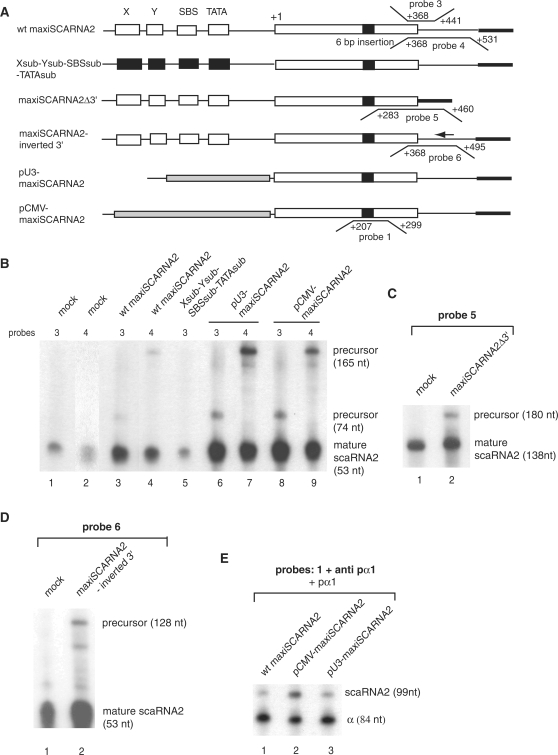Figure 4.
The 3′ flanking genomic region of the SCARNA2 gene is not required for the processing step and the mature scaRNA2 can be produced from various Pol II promoters. (A) Structures of the various templates used in the analyses. Probes 1, 3–6 and their hybridization regions in the nontranscribed strand are indicated (wt gene numbering). (B) Various Pol II promoters produce correctly 3′-end processed scaRNA2. HeLa cells were transfected with the constructs indicated above the lanes. After quantitation, the signal/mock ratios in lanes 3–9 relative to the mature RNA are: 3.25 ± 0.25, 5 ± 0.3, 1 ± 0.1, 6.7 ± 0.35, 13 ± 0.5, 9.25 ± 0.4, 11 ± 0.25. Results from lane 2 arose from a longer exposure. (C) Deletion of the 3′ flanking genomic region of the SCARNA2 gene does not impede production of the mature scaRNA2. Signal/mock ratio relative to the mature RNA in lane 2: 2.5 ± 0.3 (D) The mature scaRNA2 can be obtained with a construct harboring the 3′-flanking region in an inverted orientation. Signal/mock ratio relative to the mature RNA in lane 2: 3.5 ± 0.5. (E) The U3 snoRNA and CMV promoters are compatible with scaRNA2 production. RNA extracted from cells transfected with the constructs indicated above the lanes were analyzed by RPA with the indicated probe. pα1: vector used as the internal transfection control; anti pα1: probe monitoring the RNA produced from the transcribed pα1 gene. scaRNA2 and α: protected RNAs derived from the scaRNA2 and pα1 globin internal standard. Normalized transcriptional activity values: wt, 100%; pCMV-maxiSCARNA2, 300 ± 25%; pU3-maxiSCARNA2, 145 ± 15%. The lengths of protected fragments are indicated (nt). Data presented in (B–D) are representative views of experiments performed in triplicate.

